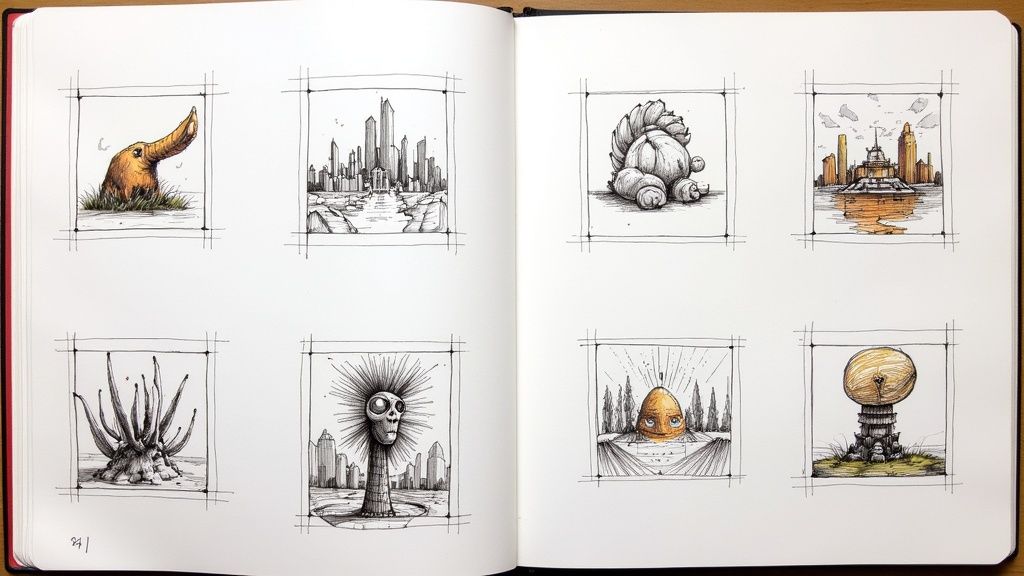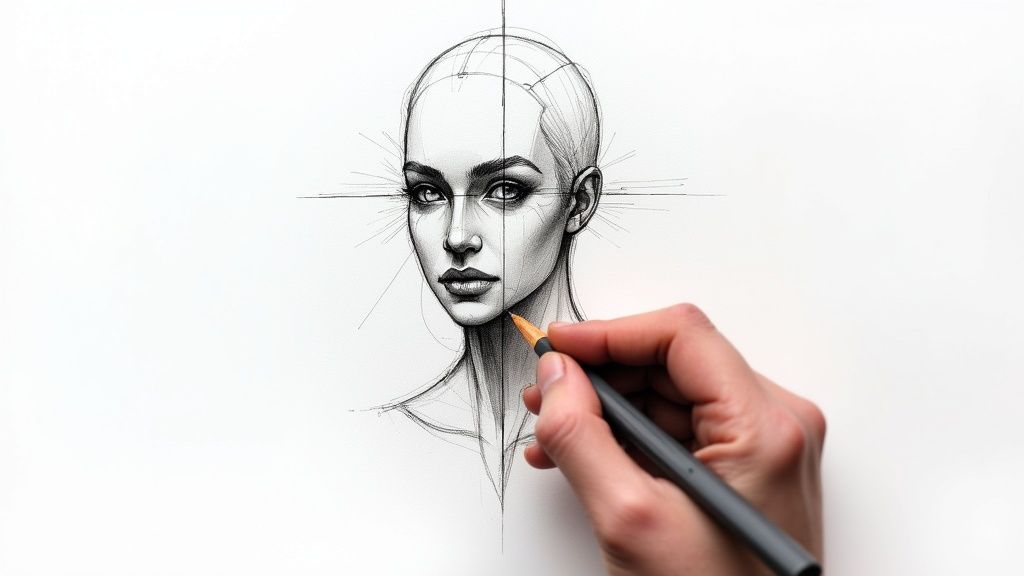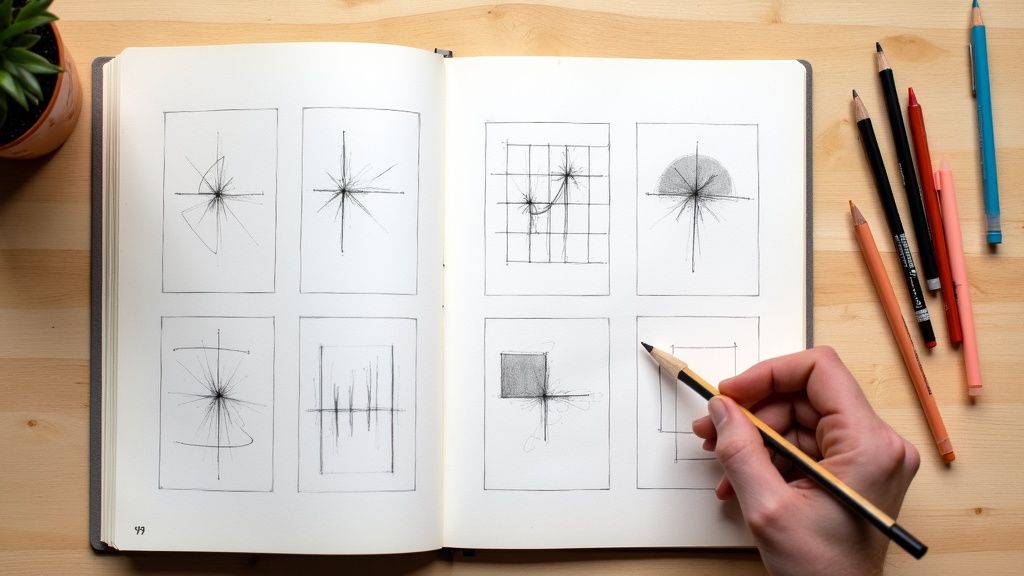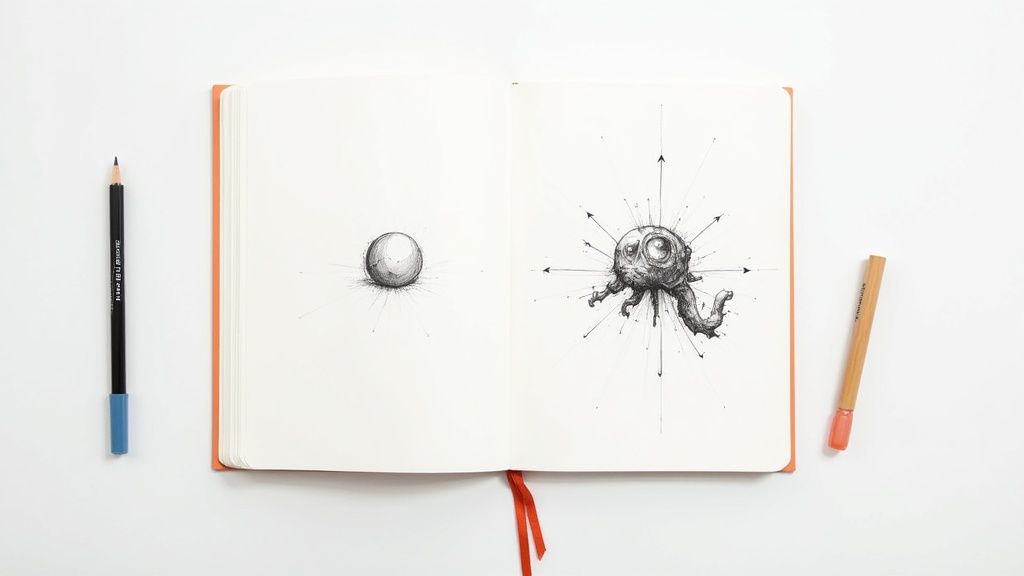Staring at a blank page can be intimidating for any artist, from seasoned professionals to weekend hobbyists. The dreaded 'artist's block' is a universal challenge, but the solution is often simpler than you think: a great prompt. A well-crafted prompt acts as a key, unlocking doors to creativity you didn't even know were there. It provides a starting point, a set of creative constraints that paradoxically sets your imagination free. This guide moves beyond generic suggestions to offer a curated selection of genuinely fun drawing prompts designed to challenge your skills, push your boundaries, and make the act of creating an exciting adventure again.
We will explore unique concepts, each packed with actionable tips and practical examples to help you transform a simple idea into a compelling piece of art. Forget the pressure of inventing a masterpiece from scratch. Instead, these prompts provide a structured playground for your mind, allowing you to focus on what you love most: the process of drawing itself. Whether you want to design fantastical animal hybrids, reimagine timeless fairy tales in modern settings, or give personality to everyday objects, these prompts are your toolkit for building a consistent, joyful, and inspired creative practice. Prepare to banish the blank page for good and rediscover the simple pleasure of bringing new ideas to life.
1. Animal Hybrids and Mashups
One of the most enduring and fun drawing prompts is creating animal hybrids. This challenge involves blending the anatomy, textures, and characteristics of two or more distinct species into a single, cohesive, and imaginative creature. It’s an exceptional exercise in creativity and a fantastic way to sharpen your understanding of animal anatomy by deconstructing and reassembling familiar forms.
This prompt pushes you beyond simple observation, forcing you to consider how different biological systems might merge. Would a creature with the body of a gorilla and the head of an eagle have feathers, fur, or a mix of both? How would its skeletal structure support both powerful wings and muscular arms? This is where your problem-solving skills as an artist truly shine.
Animal Hybrids and Mashups
How to Create Believable Hybrids
Creating a successful animal mashup goes beyond just sticking a cat head on a fish body. The key is to blend the elements thoughtfully so the final creature feels plausible, even if it's fantastical.
Start with a Strong Concept: Begin by choosing two animals. For an easier start, pick animals with similar body plans, like a wolf and a deer. For a greater challenge, combine creatures from different environments, such as an octopus and a giraffe.
Focus on Key Features: Instead of trying to merge every single trait, select one or two dominant features from each animal to highlight. For a "shark-cheetah," you might focus on the cheetah's sleek, spotted body and powerful legs but give it the shark's dorsal fin, gills, and formidable jaws.
Use Anatomical References: Ground your fantasy in reality. Pull up reference photos of both animals' skeletons, musculature, and skin or fur textures. Understanding the underlying structure will help you create a more convincing combination.
Consider the Environment: Think about where your new creature would live. A "polar bear-crab" hybrid would likely have a thick, white, chitinous shell to survive in the arctic. This environmental context adds a layer of believability and storytelling to your design.
2. Everyday Objects as Characters
Transforming mundane items into lively characters is one of the most imaginative and fun drawing prompts available. This challenge involves anthropomorphizing everyday objects, giving them personalities, emotions, and a story. It's a powerful exercise in character design and storytelling, encouraging you to find personality in the most unexpected places, from a grumpy coffee mug to a cheerful, adventurous backpack.
This prompt is exceptional for developing your ability to convey emotion and character through simple shapes and features. How would a shy, introverted book hold itself compared to an old, wise one? What kind of face would a hyperactive stapler have? This creative task sharpens your skills in simplification and exaggeration, which are fundamental to animation and illustration.
Everyday Objects as Characters
How to Bring Objects to Life
Creating a compelling object-character is about more than just adding eyes and a mouth. The goal is to infuse the object's core identity with a believable personality that feels authentic to its form and function.
Anchor Personality in Function: Start by considering the object's primary purpose. A toaster's job is to pop up toast, which could translate into an energetic, surprising, or easily startled personality. A sturdy, reliable armchair might be a wise, comforting, grandfatherly figure.
Keep Expressions Simple but Effective: You don't need complex facial anatomy. Simple dots for eyes and a curved line for a mouth can convey a wide range of emotions. Focus on how eyebrows, eye shape, and mouth curvature communicate feelings like joy, sadness, or anger.
Consider the Object's "Lifestyle": Think about the environment where your object exists. A worn-out, chipped teacup might have a rich history and a wistful personality. A brand-new, high-tech gadget could be arrogant, naive, or eager to prove its worth.
Exaggerate Defining Features: Identify the object's most recognizable features and use them to enhance the character design. The long, flexible neck of a desk lamp could be used to express curiosity or shyness, while the sharp point of a pencil might reflect a sharp, witty personality.
3. Draw Your Day in 6 Panels
Visual journaling offers a compelling way to document your life, and summarizing your day in six comic-style panels is one of the most accessible and fun drawing prompts for this practice. This exercise challenges you to become a storyteller, boiling down 24 hours of experiences, emotions, and moments into a concise, sequential narrative. It’s an excellent way to practice composition, character consistency, and narrative pacing on a small, manageable scale.
This prompt forces you to think like a director, selecting the key "scenes" that define your day's arc. From the first sip of morning coffee to a late-night thought, each panel is a snapshot that contributes to a larger story. This daily practice not only improves your drawing speed but also cultivates a deeper sense of mindfulness as you learn to observe and appreciate the small details of your everyday life.
Draw Your Day in 6 Panels
How to Craft a Daily Comic
Creating a six-panel summary is less about artistic perfection and more about honest storytelling. The goal is to capture a feeling or a memory, not to create a masterpiece every day. Many artists find this exercise helps them develop a personal style with simple, easy drawings.
Choose 6 Key Moments: At the end of your day, reflect on what happened. Select moments that represent a clear beginning, middle, and end. This could include your morning routine, a significant work task, a funny interaction, your dinner, and winding down.
Focus on Storytelling, Not Perfection: Use simple, expressive figures and backgrounds. Stick figures or simplified caricatures of yourself are perfectly fine. The emphasis is on conveying the action and emotion within each panel clearly and efficiently.
Include Both Actions and Emotions: Don't just show what you did; show how you felt. A panel could be dedicated to a feeling of frustration in traffic, a moment of joy, or the quiet comfort of reading a book. This emotional layer makes the comic more relatable and personal.
Keep Panels Consistent: Use a consistent grid or panel size to give your daily comic a cohesive look. This structure helps the reader's eye move smoothly through your story and makes the daily entries feel like part of a larger collection. For more tips on simplified art, you can find inspiration for easy drawings to draw to get started.
4. Food with Faces and Emotions
One of the most charming and fun drawing prompts is giving inanimate food items human-like faces and emotions. This challenge blends the technical skill of food illustration with the creative art of character design, allowing you to turn a simple apple or a slice of cake into a personality-filled character. It's a fantastic exercise for practicing expression and storytelling in a simple, accessible format.
This prompt encourages you to think about personification and how to convey feelings through minimal features. What emotion would a lonely donut in a bakery box feel? How would a spicy chili pepper express its fiery personality? These questions push you to create narratives within a single image, making your art more engaging and often humorous. For artists interested in this style, you can find a wealth of inspiration from various cute drawing ideas on drawinglist.com.
Food with Faces and Emotions
How to Bring Your Food to Life
Creating a compelling food character is about more than just drawing two dots and a smile. The key is to make the expression and personality feel authentic to the food item itself.
Match Personality to Food Type: Think about the inherent characteristics of the food. A lemon might have a sour, grumpy face, while a sweet strawberry could be cheerful and happy. A cup of coffee could be energetic and wide-eyed, or tired and yawning before it's been "activated."
Use Natural Features as Guides: Look for existing shapes on the food to place facial features. The seeds on a strawberry can become freckles, the stem of an apple could be a nose or a tuft of hair, and the layers of a sandwich can define the structure of a face.
Explore Emotional Scenarios: Don't just stick to happy faces. Draw a terrified piece of toast popping out of a toaster, a sad, melting ice cream cone on a hot day, or a group of grapes gossiping. These scenarios add a layer of storytelling that makes your drawing more memorable.
Play with Scale and Simplicity: Sometimes, the simplest faces are the most effective. Inspired by Japanese kawaii culture, a few simple dots for eyes and a small line for a mouth can create an incredibly endearing character. Tiny faces on large food items, like a watermelon, can also create a humorous and charming contrast.
5. Reimagine Fairy Tales in Modern Settings
One of the most imaginative and fun drawing prompts involves transplanting classic fairy tales into contemporary settings. This challenge asks you to explore how timeless stories like "Cinderella" or "Little Red Riding Hood" might unfold in a world of smartphones, social media, and urban landscapes. It’s a powerful exercise in storytelling, character design, and world-building that bridges the gap between classic fantasy and modern reality.
This prompt encourages you to think critically about the core themes and conflicts of a story and how they would be affected by technology and current social norms. Would Snow White's evil queen be a clout-chasing influencer with a "magic mirror" app that ranks people's beauty? Would Rapunzel be a sequestered influencer trapped in a high-rise apartment by an overbearing manager? These questions push your creativity beyond simple illustration and into the realm of conceptual art.
How to Modernize a Classic Tale
Creating a successful modern fairy tale adaptation means retaining the essence of the original while thoughtfully updating its elements. The goal is to make the story resonate with a contemporary audience.
Identify the Core Conflict: Start by boiling the original story down to its central theme. "Beauty and the Beast" is about seeing past superficial appearances, while "The Little Mermaid" is about sacrificing one's identity for love. Keep this core conflict intact.
Find Modern Equivalents: Translate historical or magical elements into modern-day equivalents. A royal ball could become a highly exclusive Met Gala event, a glass slipper might be a one-of-a-kind designer heel, and a cursed spinning wheel could be a piece of malware that bricks a computer.
Integrate Technology: Consider how modern technology would fundamentally alter the plot. A GPS on Little Red Riding Hood's phone might help her avoid the wolf, or Cinderella could use a ride-sharing app instead of a pumpkin carriage. This creates interesting narrative possibilities and challenges.
Update Characters and Fashion: Reimagine the characters' aesthetics. What would the seven dwarves wear in a modern urban setting? Perhaps they are a scrappy tech startup team. Design their costumes, hairstyles, and accessories to reflect current trends while still hinting at their original personalities.
6. Draw Sounds as Visual Shapes
This synesthetic drawing exercise challenges you to translate an auditory experience into a visual medium. The goal is to represent sounds, from music to ambient noise, as abstract or representational shapes, colors, and textures. This is one of the more unique and fun drawing prompts because it forces you to think abstractly and develop a personal visual language for a non-visual concept.
This prompt is an excellent way to break out of a creative rut by bypassing the analytical part of your brain that focuses on realism. It encourages you to respond emotionally and intuitively to what you hear, exploring the relationship between different senses. How does a sharp, sudden clap look compared to the long, low rumble of thunder? This exercise taps into the abstract expressionism of artists like Wassily Kandinsky, who famously painted his experience of listening to music.
How to Visualize Audio Experiences
The beauty of this prompt lies in its subjectivity; there is no right or wrong way to draw a sound. The key is to let the audio guide your hand and your artistic choices without overthinking the outcome.
Start with Simple, Distinct Sounds: Begin with clear and isolated noises to avoid feeling overwhelmed. Try drawing the sound of a single piano key, a ringing bell, a dog's bark, or a door slamming shut. This helps you focus on translating one specific audio cue into a visual mark.
Use Color and Value to Convey Emotion: Assign colors to different pitches, tones, or instruments. You might associate high, cheerful notes with bright yellows and oranges, while deep, somber tones could be represented by dark blues and purples. Use line weight and value (lightness or darkness) to show intensity or volume.
Let Shapes and Lines Define Rhythm: Translate the rhythm and texture of a sound into the shapes you draw. A fast, staccato beat might become a series of sharp, jagged lines or dots. A smooth, flowing melody could be a long, curving, graceful line.
Draw While Listening: The most effective approach is to create in real time. Put on a piece of music, close your eyes for a moment to absorb it, and then let your pen or brush move with the sound. Try different genres, from classical and jazz to electronic and ambient, to see how they inspire different visual results.
7. Invented Sports and Their Equipment
A truly imaginative and fun drawing prompt is to design a completely new sport from the ground up. This challenge goes beyond character creation, asking you to invent the rules, playing field, equipment, and even the uniforms for a fictional athletic contest. It’s a powerful exercise in world-building and product design, blending creativity with practical problem-solving.
This prompt encourages you to think about how form follows function. What kind of equipment would be needed for a zero-gravity race? How would a uniform be designed for an underwater wrestling match? Answering these questions forces you to consider physics, ergonomics, and visual storytelling, making it a fantastic way to develop your design skills. The best part is that there are no wrong answers, only creative solutions.
How to Design an Original Sport
Creating a convincing new sport involves more than just a cool name; it requires thoughtful consideration of its mechanics and aesthetics. The goal is to design a concept that feels both innovative and plausible within its own world.
Start with a Core Mechanic: Begin with a simple objective. Is the goal to score points, capture an object, or reach a finish line? Define the central action, like "launching glowing orbs through hovering rings" or "navigating a maze on bouncing stilts."
Design Functional Equipment: The equipment should directly support the core mechanic. If your sport involves high-speed aerial maneuvers, players might need specialized jetpacks, aerodynamic helmets, or magnetic boots. Sketch out diagrams and blueprints for key items.
Consider the Players and Field: Think about who plays this sport. Are they humans, robots, or aliens? Their physical abilities will dictate the rules and the design of the playing area. A sport for creatures with four arms will look very different from a human one.
Visualize the Spectator Experience: How would someone watch this game? Consider camera angles, scoreboards, and team colors. Designing for spectators adds a layer of realism and helps you think about the sport's visual identity and branding. This kind of world-building is one of many great drawing prompts for adults that can expand your creative horizons.
8. Design Your Dream Tiny House
Combining architecture, interior design, and personal expression, this prompt challenges you to design a compact and efficient living space. The goal is to create a fully functional home within a very small footprint, forcing you to think creatively about space, storage, and multi-purpose design. It’s an excellent way to practice perspective, scale, and spatial reasoning while imagining a lifestyle of minimalist simplicity.
This prompt is more than just drawing a small building; it's a deep dive into user-centered design. You must consider every square inch, asking how the space will be used by its inhabitant. How does light enter the home? Where will someone store their clothes, cook a meal, or relax? Answering these questions through your drawing transforms a simple sketch into a thoughtful architectural concept.
How to Create a Functional Tiny House Design
A successful tiny house design is a masterclass in efficiency and clever solutions. The key is to blend aesthetic appeal with practical, real-world functionality, making the space feel both beautiful and livable.
Start with Your Needs: Before you draw a single line, list the absolute essentials. Do you need a dedicated workspace, a large kitchen, or a cozy reading nook? Design the layout around these core needs to ensure the home supports your lifestyle.
Create Both Floor Plans and Perspectives: Begin with a top-down floor plan to map out the layout and ensure everything fits. Then, switch to a 3D perspective or isometric view to bring the space to life, showing how the different areas flow together and what the interior feels like.
Incorporate Multi-Functional Elements: The best tiny house designs make every component work harder. A staircase can double as a set of drawers, a dining table can fold down from a wall, and a sofa can hide a large storage compartment.
Use Real-World Inspiration: Look at actual tiny house builds on platforms like YouTube or Pinterest. Pay close attention to how designers solve common problems like storage, plumbing, and creating a sense of openness in a confined area. This research grounds your fun drawing prompts in practical reality.
Fun Drawing Prompts: Side-by-Side Comparison
Prompt Title | Implementation Complexity | Resource Requirements | Expected Outcomes | Ideal Use Cases | Key Advantages |
|---|---|---|---|---|---|
Animal Hybrids and Mashups | Moderate to High | Animal references, anatomy knowledge | Unique creatures blending real and fantasy | Concept art, fantasy illustration, creative challenges | Improves anatomy skills; sparks creativity |
Everyday Objects as Characters | Low | Familiar objects, basic character design | Relatable anthropomorphic characters | Character design, storytelling, social media content | Builds character skills; easy and fun |
Draw Your Day in 6 Panels | Moderate | Daily observation, comic layout skills | Personal visual diary, storytelling practice | Visual journaling, webcomics, mindfulness | Enhances sequential storytelling; personal |
Food with Faces and Emotions | Low | Food references, color skills | Cute, emotional food illustrations | Social media art, branding, children’s books | Universally appealing; practices color render |
Reimagine Fairy Tales in Modern Settings | Moderate to High | Story knowledge, cultural research | Contemporary fairy tale adaptations | Editorial illustration, narrative art | Fresh perspectives; develops concept skills |
Draw Sounds as Visual Shapes | Moderate | Abstract thinking, color theory | Abstract sound-inspired visual art | Experimental art, synesthesia exploration | Encourages abstraction; personal expression |
Invented Sports and Their Equipment | High | Design, physics, ergonomics knowledge | Innovative sport and equipment concepts | Concept design, product development, world-building | Develops product design; interdisciplinary |
Design Your Dream Tiny House | Moderate to High | Architectural knowledge, planning tools | Practical tiny house designs | Architecture, interior design, sustainable living | Realistic designs; practical problem solving |
From Prompt to Masterpiece: Your Creative Journey Starts Now
We've explored a wide spectrum of creative catalysts, from the whimsical challenge of creating animal hybrids to the architectural puzzle of designing a dream tiny house. Each of the eight fun drawing prompts shared in this article is designed to do more than just fill a blank page; they are structured invitations to push the boundaries of your imagination and refine your artistic skills in a low-pressure, enjoyable way. The journey from a simple idea to a finished piece is where true creative growth happens.
The power of a great prompt is its ability to provide a starting point, a single spark that can ignite a bonfire of creativity. By transforming everyday objects into characters or reimagining classic fairy tales in a modern context, you are actively training your brain to see the world differently. You learn to find stories in the mundane, to translate abstract concepts like sound into visual forms, and to build entire worlds from a single "what if" question. This is the core value of consistent creative practice.
Key Takeaways for Your Artistic Practice
To truly make the most of these ideas, it's essential to move from passive reading to active creation. Here are the most important takeaways to remember as you embark on your next drawing session:
Embrace the Process, Not Perfection: The goal of using a drawing prompt isn't to create a flawless masterpiece on the first try. The objective is to explore, experiment, and enjoy the act of making art. Allow yourself the freedom to make mistakes, try weird ideas, and see where the journey takes you.
Combine and Conquer: Don't feel limited to a single prompt. What happens if you try to draw a food character inside their dream tiny house? Or illustrate an invented sport played by your unique animal hybrid? Combining prompts can lead to surprisingly original and compelling compositions.
Technique Follows Imagination: Prompts are excellent tools for targeted skill development. Drawing your day in six panels hones your storytelling and composition skills. Visualizing sounds as shapes forces you to think abstractly and experiment with line, form, and texture. Let the creative challenge guide your technical practice.
Your Actionable Next Steps
Inspiration is a powerful but fleeting force. The key to artistic development is to build a sustainable habit of creation. The prompts in this article are your launchpad. Your next step is to choose one that genuinely excites you, grab your favorite tools, and dedicate even just 15-20 minutes to bringing it to life.
Don't wait for the perfect moment or the perfect idea. The act of starting is often the hardest part. By consistently engaging with fun drawing prompts, you build creative momentum and strengthen your artistic voice. Remember, every complex illustration and every celebrated work of art began exactly where you are now: with a blank surface and a simple idea. Your next creative breakthrough is just one prompt away.
Ready for an endless supply of inspiration? If you're looking for thousands of unique and fun drawing prompts across dozens of categories, check out the idea generators at Drawing List. It's the perfect tool to eliminate creative block for good and keep your artistic journey moving forward. Discover your next great idea at Drawing List today



